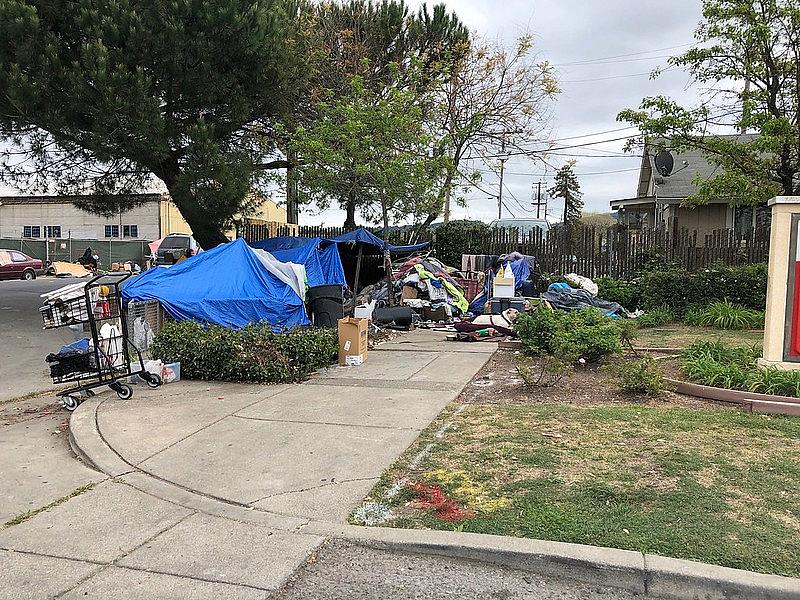Sonoma County turns to mobile crisis units to save lives

Sonoma County has been heavily impacted by the opioid crisis, homelessness and mental health challenges.
Photo by Zena Bounsall via Flickr/Creative Commons
There’s been an ongoing national conversation about policing in the U.S. for longer than I’ve been alive, but that conversation changed radically after the summer of 2020, when the killing of unarmed Black citizens including George Floyd and Breonna Taylor brought mainstream attention to police brutality and systemic racism in the U.S. As those conversations developed, and as more police killings gained national attention, it became obvious that there are catastrophic flaws in the overlap between mental health issues and policing. Police are not social workers, and they’re often ill-equipped to help folks dealing with substance abuse or mental health issues, and yet our society offers few options for a person dealing with a mental health crisis other than to call 911.
Over the last few years, cities throughout the country have attempted to respond to this crisis by developing “non-police response programs” — variations on the idea of mental health crisis response teams. Now, almost every major city in the U.S. has an alternative for people dealing with a mental health crisis, but there’s no single blueprint. In the Bay Area alone, there’s the Street Crisis Response Team (SCRT) in San Francisco, the Mobile Assistance Community Responders of Oakland (MACRO) in Oakland, the Angelo Quinto Crisis Response Team (AQCRT) in Antioch, the Specialized Care Unit in Berkeley, and the Community Crisis Response Program (CCRP) in Richmond.
These programs differ widely in almost every way imaginable, from who’s on the teams, to how they are trained, to how they’re funded, to how they’re contacted.
At the end of 2023, I was invited to tag along with Oakland’s MACRO program in order to do a story. I witnessed firsthand the types of services they offered, the training they received, the coordination (and lack thereof) they had with other government offices, and the true crisis of homelessness and substance abuse they were facing. My reporting revealed some major flaws in their system, but it also highlighted the program’s potential to help some of Oakland’s most vulnerable communities.
Over the last several years, California Gov. Gavin Newsom has taken a big swing at addressing homelessness, substance abuse and mental health issues in California. One of those efforts involved the implementation of the “Medi-Cal Mobile Crisis Services” benefit, a statewide initiative to add community-based mobile crisis intervention services to Medi-Cal, which is California’s Medicaid program. This initiative, and its associated funding, sparked the creation of a countywide non-police response program in Sonoma County.
Already, Sonoma’s program is looking significantly different from other Bay Area programs: It’s supposed to operate 24/7 and be available through a phone number that is separate from 911. Teams will include someone who is trained to administer Naloxone, someone who can deliver a crisis assessment, and a mental health or substance abuse professional.
It’s logical that the program would be different from others in the Bay Area. Sonoma’s rural geography sets it apart from other Bay Area cities. It’s also one of the cities that’s been most impacted by the opioid crisis and its concurrent issues: homelessness and mental health. As the program tries to address some of Sonoma’s biggest challenges, how well will it work, and what can other cities learn from the results?
One of the biggest challenges Oakland’s MACRO program faced was routing their services through 911 — training already overworked dispatchers didn’t go well. And some think it made their program less accessible to those who need it. In the words of one organizer I interviewed, “There are some people who will never call 911. Ever. They can’t risk the cops showing up.”
But having a number separate from 911 poses its own challenges. Who’s to say that someone will remember a unique seven-digit number in a true emergency?
With all that in mind, Sonoma has made the decision to route their mobile crisis units through a number separate from 911, a decision that sets them apart from other Bay Area non-police response programs and merits investigation.
Sonoma’s program is also unique in the collaboration it will have with doctors and other health care professionals. While many cities have intended to provide full “wraparound services” to those who need it, a lack of coordination between nonprofits, social workers, governments, and health care professionals has made this challenging.
How will the involvement of doctors and health care professionals affect Sonoma’s plans to provide true wraparound services? Will they develop, or at least facilitate, long-term care-oriented relationships with clients, or will they become overwhelmed and bogged down by the workload, defeated by the bureaucratic hurdles and sheer magnitude of need in the county?
In late spring, I will spend several days in Sonoma County, tagging along with the mobile crisis units — interviewing staff, health care workers, policy makers and the Medi-Cal patients receiving their services. My broader goal for this project, supported by the 2024 California Health Equity Fellowship, is to provide a comprehensive and compelling analysis of Sonoma’s rollout of a county wide non-police response program.
